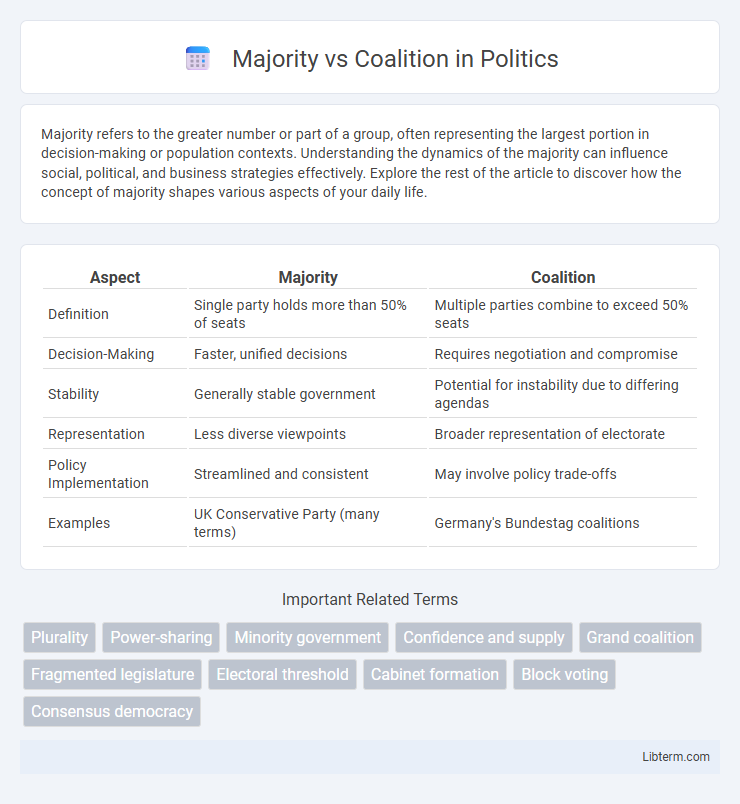Majority refers to the greater number or part of a group, often representing the largest portion in decision-making or population contexts. Understanding the dynamics of the majority can influence social, political, and business strategies effectively. Explore the rest of the article to discover how the concept of majority shapes various aspects of your daily life.
Table of Comparison
| Aspect | Majority | Coalition |
|---|---|---|
| Definition | Single party holds more than 50% of seats | Multiple parties combine to exceed 50% seats |
| Decision-Making | Faster, unified decisions | Requires negotiation and compromise |
| Stability | Generally stable government | Potential for instability due to differing agendas |
| Representation | Less diverse viewpoints | Broader representation of electorate |
| Policy Implementation | Streamlined and consistent | May involve policy trade-offs |
| Examples | UK Conservative Party (many terms) | Germany's Bundestag coalitions |
Defining Majority and Coalition
A majority refers to a situation where a single political party or group holds more than half of the seats or votes, enabling them to make decisions independently. A coalition is formed when two or more parties or groups join forces to combine their seats or votes, achieving a majority together without any single party having an absolute majority alone. The distinction lies in majority representing sole control, while coalition implies cooperative governance through alliance.
Historical Context of Majority Rule
Majority rule has been a fundamental principle in democratic governance since ancient Greece, notably in the Athenian assembly where decisions were made based on the preference of the greater number of citizens. The development of majority rule shaped Western political systems, emphasizing the importance of the collective will while balancing minority rights. Historical shifts from absolute monarchies to representative democracies highlight the evolution of majority rule as a mechanism for legitimizing political authority and ensuring accountability.
Formation and Structure of Coalitions
Coalition formation occurs when multiple political parties or groups collaborate to establish a governing majority, often in parliaments where no single party holds an outright majority. The structure of coalitions typically involves negotiated agreements on policy priorities, distribution of cabinet positions, and shared governance responsibilities to maintain stability and achieve collective goals. Unlike a majority formed by a single party, coalitions require ongoing consensus-building and compromise among partners to sustain effective governance.
Advantages of Majority Governments
Majority governments provide greater stability and efficiency in decision-making due to having more than half the seats in the legislature, allowing them to pass laws without needing support from other parties. This control facilitates quicker implementation of policy agendas and reduces the likelihood of government collapse triggered by votes of no confidence. Furthermore, majority governments enhance accountability, as a single party is responsible for governance, making it easier for voters to attribute successes or failures.
Benefits and Challenges of Coalition Governments
Coalition governments offer the benefit of broader representation by uniting multiple political parties, which can lead to more balanced policy-making and greater public support. These governments, however, face challenges in achieving consensus among diverse parties, often resulting in slower decision-making processes and potential political instability. Despite these difficulties, coalitions can enhance democratic legitimacy by accommodating varied interests within the electorate.
Impacts on Policy Making
A majority government, holding over half the seats, enables swift policy implementation due to solid legislative support and reduced negotiation needs. In contrast, coalition governments require consensus-building among diverse parties, leading to compromises that can slow decision-making but often result in policies reflecting broader interests. The stability of a majority facilitates consistent policy agendas, while coalitions promote inclusivity and adaptability in policymaking.
Stability and Longevity: Majority vs Coalition
Majority governments typically offer greater stability and longevity due to unified party control over legislative agendas, reducing the risk of internal conflicts. Coalition governments, formed by multiple parties, often face challenges in maintaining consensus, leading to potential instability and shorter tenure. Historical data shows that majority administrations tend to last longer and govern more effectively compared to fragmented coalitions prone to compromise and dissent.
Representation and Inclusivity
Majority governments secure over half the seats, enabling decisive policy implementation but may marginalize minority voices. Coalition governments, formed through alliances among multiple parties, enhance representation by incorporating diverse political perspectives and interests. This inclusivity fosters broader consensus and encourages compromise, reflecting a wider spectrum of the electorate.
Case Studies: Majority and Coalition in Practice
Majority governments, such as the Conservative Party in the UK from 2015 to 2017, demonstrate stability and clearer policy implementation due to holding over 50% of parliamentary seats. Coalition governments like Germany's CDU/CSU and SPD alliance since 2013 illustrate power-sharing dynamics, requiring negotiation and compromise between parties to achieve legislative goals. Case studies reveal that majority governments often expedite decision-making, while coalitions foster inclusive governance but face challenges in policy consensus.
Conclusion: Choosing Between Majority and Coalition
Choosing between a majority and a coalition depends on political stability and policy alignment; majorities provide straightforward governance with clear mandates, while coalitions require negotiation but offer broader representation. Majority governments expedite decision-making due to unified party control, whereas coalitions often reflect diverse interests, leading to compromise and inclusivity. Evaluating electoral context, party dynamics, and legislative goals guides the strategic selection for effective governance.
Majority Infographic

 libterm.com
libterm.com